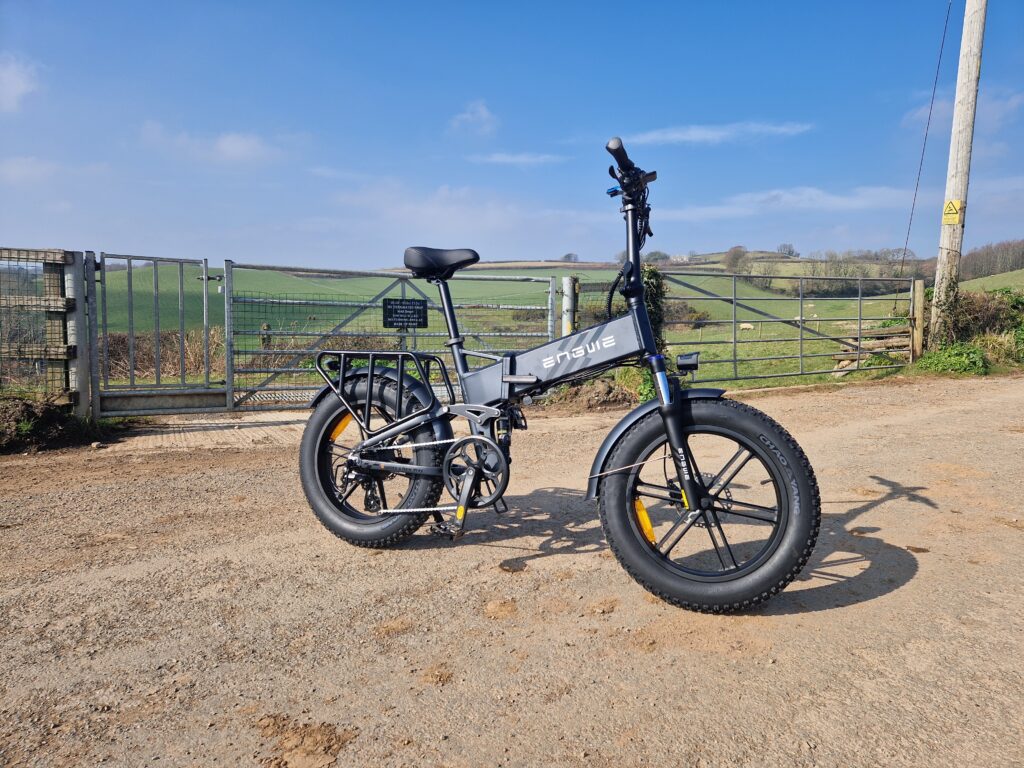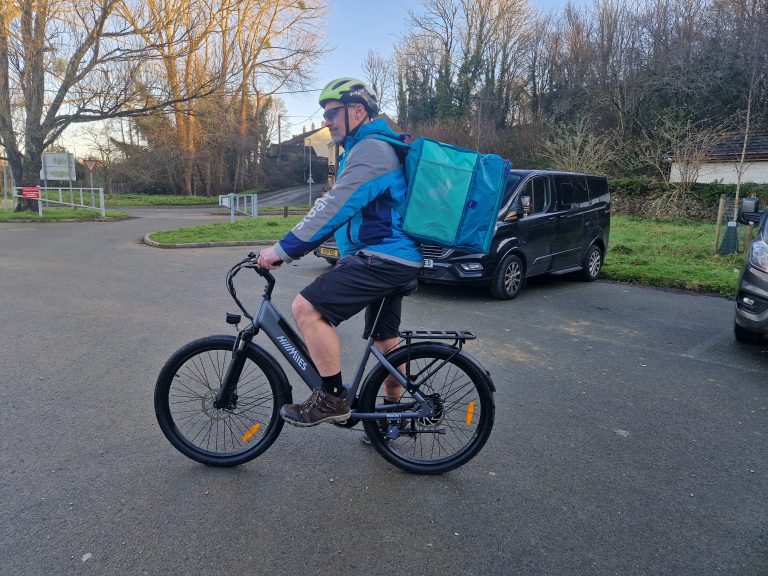Engwe Engine Pro 2.0 Review
As part of my ongoing journey into the world of side hustles, I’ve tested a range of e-bikes to see which are best suited for delivery riders. The Engwe Engine Pro 2.0 is a folding, fat-tyre electric bike that’s an updated version of the original Engine Pro, first released in 2022. This latest model features a more powerful 52-volt battery and a torque-sensing pedal assist—two upgrades that should improve battery range and rideability. I’ve been using the Engine Pro 2.0 for my Stuart delivery work to see how well it handles the steep and unforgiving Plymouth hills.
Disclaimer: The original Engine Pro was marketed with a 1000w power output and shipped unrestricted. In contrast, the 2.0 version tested here arrived with the top assisted speed capped at 15.5 mph (25 km/h), and the throttle limited to 6 km/h, keeping it in line with UK e-bike laws. However, Engwe’s website doesn’t state the motor as 250w, required for legal classification, but instead highlights a peak power of 1200w, creating some ambiguity around its legal status.
Engwe Engine Pro 2.0 Review Summary

A lot of e-bike for the price, but it has flaws and quirks.
Pros
Powerful motor
Comfortable ride
Good spec for the price
Cons
Unrefined pedal assist
Heavy and awkward to store and transport
Disappointing battery range
Unboxing and first impressions
The Engwe Engine Pro 2.0 is a heavy bike, it arrived well packed in a large, sturdy box. I managed to get it downstairs into my backyard, but it was a real struggle. If you’re not used to handling or assembling bikes, be warned—there’s quite a bit to do, and I’d recommend having someone help you.
Once you’ve removed the acres of packaging and countless cable ties, several components must be fitted and adjusted before riding. These include the front wheel, mudguard, front light, steerer, handlebars, rear rack, kickstand, and pedals. It took me about an hour from start to finish, but as I’ve assembled a few of these types of bikes before, it may take you longer.

It’s important to pay particular attention to the front mudguard. I learned this the hard way when I went over the handlebars while testing the Engwe L20 earlier this year. That incident was entirely my fault, but had I properly tightened the main mudguard bolt on the fork bridge, it wouldn’t have happened.
Once fully assembled, the Engine Pro 2.0 is an imposing machine. The fat tyres give it a look that’s more motorcycle than bicycle. I was impressed with the overall finish and paintwork. This model came in a stealthy matt black, which I think suits the bike.
First Ride
I fully charged the battery before my first ride, which took around four hours. For the initial outing, I decided to try my luck with an afternoon delivery shift to see if I could pick up a few orders before teatime.
I had high hopes for this bike, particularly because of the torque sensor. One of my main issues with the original Engine Pro was the delay in pedal assist and the jerky, on-and-off sensation of the cadence sensor. So, I expected this upgraded version to offer a much smoother and more responsive ride.
Unfortunately, within the first mile, my hopes were dashed. While the torque sensor does provide instant power when you start pedalling, it doesn’t feel like a true torque sensor system. Anyone familiar with proper torque-sensing e-bikes will know they respond proportionally to your pedalling effort—pedal harder, get more power; ease off, get less. On the Engine Pro 2.0, the response feels more like a glorified cadence sensor, with little variation in power delivery based on input.

Another disappointment is that you only get the full 15.5 mph (25 km/h) top speed in level 5 assist. Typically, e-bikes assist up to the legal limit in all assist levels, with the lower levels simply offering less power. This allows riders to conserve battery and only use full power when needed. Unfortunately, the Engine Pro 2.0 follows the same flawed setup I’ve seen on other Engwe bikes, forcing you to ride in level 5 constantly just to maintain a reasonable pace.
This is especially problematic given how heavy the bike is and the amount of rolling resistance from the fat tyres. Without constant power from the motor, the bike slows dramatically, making for sluggish progress.
An even bigger issue is how the motor assistance cuts out at 15.5 mph. There’s no gradual tapering—it just stops dead, like you’ve hit the brakes. The assist only kicks in again once your speed drops to around 13 mph, at which point it surges forward, then cuts out again. This creates a frustrating stop-start rhythm of acceleration and deceleration that quickly wears you down.
You can’t raise the speed limit by a few MPH either, as this function has been locked. While there is a way to fully unlock the bike, doing so removes the speed cap entirely and activates full throttle mode, rendering it completely illegal to ride on UK roads. I tried fine-tuning some of the pedal assist settings, but unfortunately, it didn’t make much difference.

Despite all of the above, when the bike is within its electric assist zone, it pulls like a train and tackles most hills with ease. Some of the gradients I face during a typical delivery shift hit 20%, and the Engwe made short work of them. As mentioned earlier, you’ll need to keep it in level 5 assist—otherwise, you’ll find yourself being overtaken by pensioners on city bikes.
The handling is decent, although not particularly sharp. It feels more like a cruiser motorcycle than an e-bike. Due to its weight, the Engwe feels planted—almost glued to the road. Like the previous model, the Engine Pro 2.0 features front and rear suspension. The front forks look beefier than those on the original and do a decent job of soaking up rough road surfaces, which we delivery riders encounter regularly. The rear suspension is okay, but it bottoms out fairly quickly. Overall, I’d describe the ride as smooth and comfortable.
The saddle is large and takes a bit of getting used to. However, after a couple of hours in the saddle, I felt reasonably comfortable.
After a short bedding-in period, the hydraulic brakes felt fine. But on longer, steeper descents, I noticed brake fade setting in fairly quickly. I had to come on and off the brakes intermittently to allow them to cool down. It’s something to be wary of—I felt the brakes reached the limit of their performance quite quickly when descending steep hills. That said, on flatter or more rolling terrain, the brakes performed well, offering good bite and modulation.
Now, onto battery range. With its 832Wh, 52-volt battery, I expected a noticeable improvement over the original model. But in reality, the range was about the same. After just 22 miles of riding, I was already down to 20% battery. Based on how it was draining, I estimated it would cut out somewhere in the high 20s or low 30s. With about four miles of mostly uphill riding left to get home, I didn’t want to risk being lumbered with a heavy e-bike and no assist, so I decided to call it a day.

When you get home and want to fold it down for storage, be prepared for a bit of a battle. At 34 kg, it’s a hefty bike, and folding it isn’t a quick or easy task. When folded, it remains bulky—you’ll struggle to fit it into the boot of a typical family hatchback. And if you live in a flat and need to navigate a narrow stairwell, I wish you the best of luck. It’s an awkward, heavy lump to carry upstairs, and not something you’ll want to do regularly.
Specification
The frame is chunky and has a utilitarian look, with industrial-style welds. Overall, it looks tough and durable, and I haven’t come across any anecdotal reports of frame issues. I’ve owned several Engwe bikes in the past and have never had problems with the frame. The cables are routed externally along the underside of the frame, which makes maintenance a little easier, if less tidy.

The original Engine Pro (MK1) came with a direct drive hub motor and a regen system, which didn’t work well—it added noticeable drag when coasting and only recovered a minimal amount of energy back into the battery. The newer 2.0 version now uses a geared rear hub motor, eliminating that drag. However, it is noisy, especially under load. The power delivery isn’t subtle either—it surges aggressively up to the 15.5 mph limit before abruptly cutting out.
The bike features a neat colour display that gives you all the basics. As mentioned earlier, there is an advanced settings menu, but tweaking these didn’t noticeably improve the pedal assist in my experience.
Battery capacity is listed at 832Wh (52v 16Ah), which on paper should outperform the original. However, in practice, it seems about the same. After three weeks of daily riding, I’ve estimated the real-world range to be around 25–30 miles using level 5 assist.

The hydraulic brakes are unbranded but work reasonably well on flatter, undulating terrain. However, on long or steep descents, they quickly overheat, leading to brake fade. You’ll need to modulate braking to prevent performance drop-off on hills.
Gearing is a step up from what you typically find on budget e-bikes. It uses a Shimano Altus derailleur with an 8-speed freewheel and trigger shifter. The gears required a little fine-tuning out of the box, but performed well after adjustment.
The wheels use a solid six-spoke mag design, heavier than traditional spoked wheels but great for daily use—you won’t be constantly dealing with broken spokes. The Chao Yang fat tyres have also proven themselves to be tough and puncture-resistant. I’ve logged over 100 miles so far without a single flat.
Accessories are generous. You get a rugged pannier rack, front and rear lights, and a kickstand. The suspension appears to have been upgraded slightly from the original, with beefier front forks. The rear suspension remains unchanged but does an okay job, despite bottoming out on larger impacts.

Sizing
These folding fat tyre e-bikes can be deceptive when it comes to size. They often look quite compact in photos, but in person, they’re large and imposing.
I’m 6 feet tall and found I could ride it comfortably. I also had family members try it out, and we found that 5ft 4in was about the lower height limit for safe and comfortable riding.
The Engwe does have height-adjustable handlebars and a good amount of seatpost adjustment. I had the seatpost close to its maximum extension, so anyone much taller than me might struggle to find an optimal pedalling height without compromising comfort or leg extension.
Alternatives
The Engwe Engine Pro 2.0 is competitively priced at £1,299, and to be fair, you’re getting a lot of bike for your money. If you’re specifically after a fat-tyre folding e-bike, there are plenty of alternatives out there. Here are three popular options worth considering:
The Varun is a folding fat tyre e-bike with a similar frame design to the Engwe, but it lacks rear suspension. It’s currently available for £749–£799, making it a more budget-friendly option. It features a 624Wh 48v battery and a 250w rear hub motor rated at 55Nm of torque. It uses basic cadence pedal assist, and the cable-operated disc brakes won’t provide the same stopping power as hydraulic brakes. Still, it’s a solid choice if your budget doesn’t stretch to the Engwe.
I tested the PVY Z20 Plus last summer. Priced at £949, it offers full suspension like the Engwe but comes with a smaller 696Wh battery and cable disc brakes. In my experience, the PVY felt more raw and unrefined than the Engwe, but it’s still a decent, cheaper alternative and might be suitable depending on your needs.
Coming in at around £1,099, the Fafree F20 Max is a folding step-through e-bike that boasts a massive 1,056Wh battery and a UK-legal 250w rear hub motor. It’s designed with utility in mind, offering excellent cargo-carrying capacity. It comes fitted with a front rack and a rear pannier rack that doubles as a seat, complete with footpegs for a passenger. If you’re looking for practicality and range, this is a strong contender.

Conclusion
The Engwe Engine Pro 2.0 is a mixed bag. While it looks good on paper, real-world use highlights several flaws. The torque-sensing assist feels crude, requiring full power mode just to average 13–15 mph, and the brakes underperform on steeper descents. At 34 kg, it’s cumbersome to lift, store, or fold, and despite a larger battery, range remains modest at 25–30 miles. That said, it’s a solidly built, comfortable bike that handles hills well, making it ideal for a delivery side hustle if you’re willing to work around its quirks.







